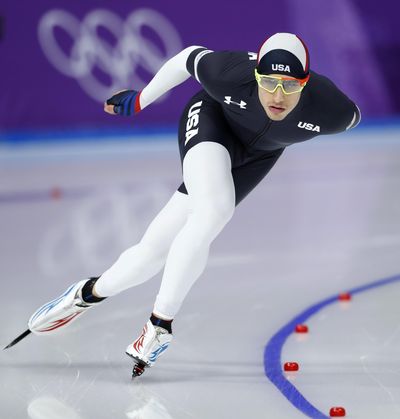Commentary: Time for U.S. speedskaters to step up in South Korea

GANGNEUNG, South Korea – They can’t blame the suits. Or their training methods.
No more excuses.
It’s time for America’s most decorated Winter Olympics program to step up in South Korea.
“I don’t think there’s a more motivated bunch of athletes here,” Brittany Bowe said. “We definitely have everything in the toolbox to be successful.”
Speedskating has long been a bellwether for the ice-and-snow crowd, producing some of the biggest U.S. stars despite a persistent lack of funding and pretty much zero recognition beyond those two weeks every four years.
From Eric Heiden to Bonnie Blair, from Dan Jansen to Apolo Anton Ohno, from Shani Davis to Chad Hedrick, the Americans could usually count on their speedskaters – whether it was short track or the big oval – to bring home plenty of hardware.
That all changed in 2014.
The long-track skaters were shut out completely.
The short trackers could only manage a relay silver on the final night of competition.
It was a performance that several athletes have repeatedly described as “a disaster.”
Well, we might know very soon if another crash-and-burn is looming.
On Monday, tune in for the women’s 1,500 meters at the Gangneung Oval. Heather Bergsma is the reigning world champion. If Bowe is in top form, she might have a shot to make the podium.
If they flop, it could be another long Olympics for the U.S. speedskaters, who finished far back in the first two long-track events and were blanked on the opening night of short track, as well.
“For sure, it’s disappointing,” said J.R. Celski, who bombed out in the semifinals of the short track 1,500. “I just gave it my best. That’s all I could’ve done.”
Over at the oval, the early returns are not encouraging.
In the women’s 3,000, Carlijn Schoutens labored across the line in 22nd place – more than 16 seconds behind the winner and ahead of only two other skaters. Her time of 4 minutes, 15.60 seconds was more than 10 seconds off her personal best.
On Sunday, Emery Lehman finished next-to-last in the men’s 5,000, his time more than 3 seconds off his winning performance at last month’s Olympic trials in Milwaukee.
“That’s definitely a little slower than I was hoping for,” Lehman said. “The ice was good, the preparation was good, it’s just on me to perform well and skate a little better than I skated.”
Four years ago, almost to the day, the U.S. speedskaters realized something was very, very wrong in Sochi. Bergsma (then known as Heather Richardson) and Bowe were among the favorites in the 1,000. Instead, they finished seventh and eighth respectively.
The rout was on.
“Our whole team was lined up watching them race,” Joey Mantia recalled. “We all looked at each other when Brittany finished and were like, ‘What do you expect us to do?’”
In retrospect, we know exactly what went wrong.
Just about everything.
U.S. officials made the downright baffling decision to switch to a new suit right before the games, convinced it would give them a huge technological edge. Instead, the skaters were saddled with tight, ill-fitting gear that might’ve actually slowed them down.
On top of that, the Americans conducted their pre-Olympic camp well above sea level at a frigid outdoor rink in Italy, even though the Winter Games were being held at an indoor rink right next to the Black Sea.
The training conditions were downright uncomfortable – especially for former inliners such as Bergsma, who grew up in North Carolina, and Florida natives Bowe and Mantia – and the faster speeds that are produced at higher altitude didn’t carry over to Sochi.
“If you take the road less traveled and it pays off, you’re a genius,” Mantia said.
“If it doesn’t,” he added, “you’re an idiot.”
No one finished higher than seventh individually. The best showing was sixth in women’s team pursuit (out of an eight-nation field).
With Ohno retired, the short track team had only a bit more success. No one was higher than fourth individually, leaving it to the men’s relay team to salvage a bit of pride with their runner-up finish in the very last race of the Sochi Games.
No one wants it to come down to that again.
The Americans insist they are fully comfortable with their suits, which they’ve been wearing for the past two seasons. Their pre-Olympic training was designed to mimic the conditions they would face in South Korea, right down to the temperature in the arena.
Now, it’s time to step up.